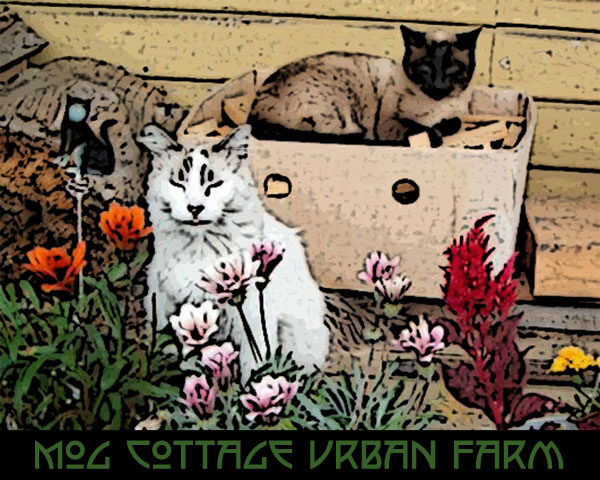 |
| Those darling little purple florets have just appeared. |
Granted, this is a variety that takes around 8 months to start producing in the first place. However, I planted the seeds in late April of 2010 and the first summer I got nothing but a thicket of 6 foot tall stalks with 2 foot long leaves that took over the entire 8 ft. by 4 ft. bed. As it turns out, this is an heirloom variety that one should plant in the fall so 8 months later you can theoretically harvest something in late summer. After discovering my oops, I overwintered the bunch but only 3 stalks made to spring. PSB is supposed to be very frost hardy, but these 3 plants survived that early big freeze we had in the fall of 2010. The next spring, those plants exploded and I had so much PSB that a lot of it flowered and ended up in the compost pile because I couldn't keep up with it. I assumed that the mass production were the plants death throws to reproduce before they droop dead. How wrong I was! The plants overwintered a second time and this year, they're producing earlier than ever only this time, I'm determined to nip this in the bud before it all gets out of control. I'll probably freeze a lot of it.
This is a great time of spring for the PSB to be putting out because it's too cold for those pesky cabbage moths and the leaves are pristine. The florets and younger leaves are also very sweet. Maybe several years of the freeze/thaw cycle has increased the sweetness. Sugars are a plant's anti-freeze and there's nothing like a frost to bring out sweetness in Brassicas. I'm chopping up and steaming the smaller leaves and the florets together.
Purple Sprouting Broccoli's culinary origins happen to go way back to the Romans who first cultivated it. Marcus Gavius Apicius, a celebrity chef of the Roman Empire, created one of the earliest known recipe books that called for broccoli to be mixed with cumin, coriander seeds, chopped onions, oil and wine. Hmmm, I wonder where I can get a copy.
Although the Brits have been growing PSB for at least the last 2 centuries, it's just starting to become more common in this country. In the UK, PSB's season is January to May. Here, it appears to be late March to when you're sick of it and let it go to seed. It's definitely a space hog and you can't expect an abundance of large big-box style florets. Visualize the shrunken heads on grown bodies in the movie Beettlejuice and you'll get an idea of the proportions of the florets to the overall plant.
I'm contemplating contacting Guiness World Records when it hits year 10 to enter it as the longest living single crop of Purple Sprouting Broccoli. I'll have to see what the current record is. I could see myself getting as obsessed as those giant pumpkin growers get, sitting up all night to keep the varmints from snacking on my charges and monitoring the plants with an IV.
My guess is that some Darwinian PSB mutation is happening with mine. Or maybe I'm not so quick to whack them down after the growing season. Much to Roland's eye-rolling, I've decided to see how long I can keep these PSB anomalies going before they finally peter out. More bang for the buck that way too. My $3 packet of seeds has gone a long way and I haven't used much fertilizer either. Who knows, this region's predictive climatic transitions to warmer and wetter might just be the ticket to the development of a new cultivar. How does Brassica oleracea 'Debra's Floret Folly' sound? I just love freakish plants, don't you?






